 Since the release of the FTW DT edition, EVGA has successfully raised the level of confusion in their GPU line-up far and beyond our Universe 7. Though that is still light years behind BMW in the naming scheme department which currently rules all 12 universes, EVGA is getting there at a happy & steady pace.
Since the release of the FTW DT edition, EVGA has successfully raised the level of confusion in their GPU line-up far and beyond our Universe 7. Though that is still light years behind BMW in the naming scheme department which currently rules all 12 universes, EVGA is getting there at a happy & steady pace.
But worry not fellow custom pc builder, here are all the differences and unique features between the EVGA REF, Founder’s, Ti, ACX, SC, SSC, FW, FW DT, ICX SC2, ICX FTW2, Black Edition, Classified and Hybrid editions at the spheres of your eyes. You will be able to pick the best EVGA graphics card for your computer at the end of this article without a doubt (according to the comment section).
Content |
*This chart also appears on the right sidebar on your desktop screen as you scroll along the article, whenever it feels like to. |
 When graphics card manufacturers –such as Zotac, PNY, Asus or EVGA– receive a batch of GPUs from the overlord NVIDIA, they will perform intense calculations to determine which tier the GPUs should be placed under, a.k.a product binning.
When graphics card manufacturers –such as Zotac, PNY, Asus or EVGA– receive a batch of GPUs from the overlord NVIDIA, they will perform intense calculations to determine which tier the GPUs should be placed under, a.k.a product binning.
Similar to every snowflake and tumblr girl known to man, none of the GPUs is identical to one another. Yet at the very least, these GPUs are all expected to meet a minimum requirement of clock speed; for instance: minimum 1100MHz.
Some of these GPUs could run at this frequency no problem; and some are better –they might be able to run at 1427MHz which is 30% faster, for more than 3 years without failure. Boom! That’s how we get a Tier 1 GPUs.
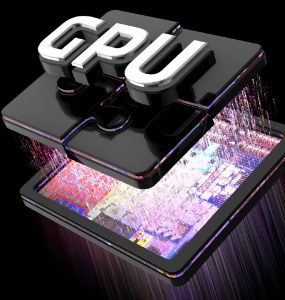 Now as you’ve just read about product binning, you should realize that there is no such thing as cherry picking on these GPUs. Yes they might be able to get clocked a little higher, but they are not the best or the unicorn rainbow part of the silicon waffle.
Now as you’ve just read about product binning, you should realize that there is no such thing as cherry picking on these GPUs. Yes they might be able to get clocked a little higher, but they are not the best or the unicorn rainbow part of the silicon waffle.
What do I mean? Assuming you are buying two GTX 1070 FTW which is strongly considered as having a Tier 1 GPUs equipped, one of them might not be as good as an overclocker as the other. In fact, one could go up to 1819MHz in clock speed while the other can’t even go above 1680MHz. And then out of nowhere you have a random GTX 1070 Superclocked that hits 1740MHz, a Tier 2 GPU! Wait…isn’t my mighty FTW edition supposed to clock higher?! What kind of sorcery is that!
At the end of the day it’s like playing a lottery, thus you may come across the term “silicon lottery” when people discuss about these video cards and their ability to go above and beyond. Getting a special edition GPU increases your chance of overclocking said GPU to a new record clock speed, but it does not 100% guarantee it will be possible at all.
The Tier 2 GPUs might be in Tier 2 because it didn’t pass some particularly harsh situations under certain overclocked speed; but in real world environment where there are fewer stress factors, some genius could potentially achieve a higher clock frequency using the same GPU.
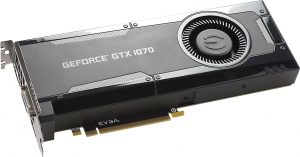 REF or Reference Edition is the most basic version of all the models in the series. It does not even have a backplate –that isn’t something very significant though, the heatsink isn’t heavy enough to cause a PCB warp without a backplate.
REF or Reference Edition is the most basic version of all the models in the series. It does not even have a backplate –that isn’t something very significant though, the heatsink isn’t heavy enough to cause a PCB warp without a backplate.
The REF model usually sports a single fan design where hot air is exhausted to the back of the chassis, also known as blower style or HSF. The cooling mechanism is pretty simple and inefficient, hence there is just a little room for overclocking –which typically yields less than 10% over stock speed. eg. stock 1506MHz, boost 1683MHz.
Under heavy load, the video card may believe itself is a vacuum or your crazy ex: loud and sucks a lot. Meanwhile, the REF edition may be the most affordable model in the family yet.
Now on the opposite side of the spectrum, the Founder’s Edition is exactly the REF edition with a more appealing aesthetic and costs quite a bit more just because.
Once the early release period of the new series is over and the market is filled with REF edition supply, the Founder’s Edition becomes more like a special limited, collector’s edition. Though I highly doubt there is any value in it since there will be newer models with better cooling and better PCB design come out in the near future. Like right now. But who knows, this article is written on Jan 1st 2017. So we could bet that once the FE edition becomes rare, it might cost 4-5 times as much just because.
REF
- Real Base Clock: 1506 MHz / Real Boost Clock: 1683 MHz; Memory Detail: 8192MB GDDR5
- EVGA GTX 1070 GAMING delivers the incredible speed and power of NVIDIA Pascal
- What you see is what you get! – No additional software required to achieve listed clock...
- DX12 OSD Support with EVGA Precision XOC
Founder’s
- Real Base Clock: 1506 MHz / Real Boost Clock: 1683 MHz; Memory Detail: 8192MB GDDR5
- EVGA GTX 1070 Founders Edition delivers the incredible speed and power of NVIDIA PascalTM
- What you see is what you get! – No additional software required to achieve listed clock...
- DX12 OSD Support with EVGA Precision XOC
The ACX edition is the advanced Reference edition which probably costs $30 more on average. But due to supply and demand, this price might be different and be in your favor if you are at the right place at a right time (hint: microcenter clearance sale).
It has the same tier GPU as the REF but equipped with better cooling design: double fans for better heat dissipation and lower noise level. Boost speed is also the same as REF’s, but you certainly can manually overclock this model a little higher thanks to the better ventilation. On a good day, you may find two different versions of this model: in silver or in black color. Wanna bet again? Black version will cost more because it looks bad ass. That’s like putting sticker on a Honda to get 20 more BHP and systhetic blinker fluid is definitely more aerodynamic than conventional.
ACX 3.0
- Real Base Clock: 1506 MHz / Real Boost Clock: 1683 MHz; Memory Detail: 8192MB GDDR5
- Run Longer, Play Longer with EVGA "ACX 3.0" Cooling
- What you see is what you get! – No additional software required to achieve listed clock...
- DX12 OSD Support with EVGA Precision XOC
ACX 3.0 Black
- Real Base Clock: 1506 MHz / Real Boost Clock: 1683 MHz; Memory Detail: 8192MB GDDR5
- Completely adjustable RGB LED using EVGA Precision XOC
- What you see is what you get! – No additional software required to achieve listed clock...
- Double BIOS. Revolutionary new 360-degree image capture
So again, what do you do with a higher Tier GPU that can overclock slightly better? Yes, we will market it differently to earn more money! The ACX Superclock edition typically has a higher base clock of at least 60MHz more when compared to REF edition, and it also has a 10% to 15% higher frequency in Boost Speed. For example: the REF of EVGA GTX 1070 has a base clock of 1506MHz, while the SC edition runs raw at 1594MHz. Under load, Boost speed of REF is up to 1683MHz, and the SC is up to 1784MHz.
Having a higher Tier GPU allows you to personally adjust your video card to a new potential. But keep in mind, even though factory overclocked card gives you 3 year warranty, once you do it on your own you’ll immediately void the warranty. In my opinion, unless the price is right you should pass the SC edition. It yield little benefit over the regular ACX models above.
- Real Base Clock: 1594 MHz / Real Boost Clock: 1784 MHz; Memory Detail: 8192MB GDDR5
- Run Longer, Play Longer with EVGA "ACX 3.0" Cooling
- What you see is what you get! – No additional software required to achieve listed clock...
- DX12 OSD Support with EVGA Precision XOC
- Real Base Clock: 1594 MHz / Real Boost Clock: 1784 MHz; Memory Detail: 8192MB GDDR5
- Run Longer, Play Longer with EVGA "ACX 3.0" Cooling. Operating system support: Windows 10...
- What you see is what you get! – No additional software required to achieve listed clock...
- DX12 OSD Support with EVGA Precision XOC. Requires Minimum of a 500 Watt power supply. Max...
There are 5 notable differences between the SSC/FTW compare to SC/REF and Founder’s Edition.
First off, SSC/FTW and FTW DT all have very cool customizable RGB LED while lower models has only a solid White LED. Pair a FTW with one these 12 chassis with transparent window for maximum lighting effect.
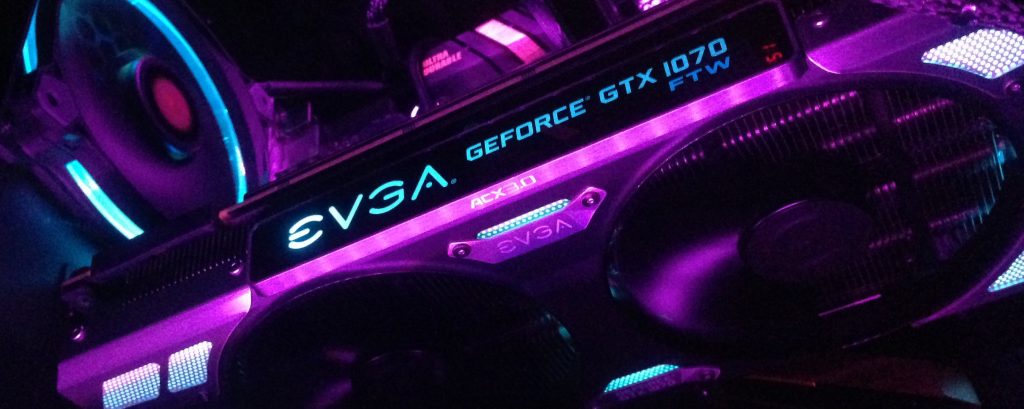
Remember that Corsair C70 case LED light show in Awesome Wall-mounted Custom PC the other day? Yeaah.
Now onto the more technical parts. Based on the product binning example at the start of this post, the SSC would have been Tier 2 and FTW is definitely in Tier 1 bracket. A lot of fun things happen in these two models. For the second difference let it be known that both GTX 10-series SSC and FTW cards have double BIOS switch while SC/REF and Founder’s has none. BIOS switch is a convenient tool to help you void warranty much more easier.
Jokes aside, the double BIOS feature lets you switch between 2 different overclocking profiles to your liking. It can also be used as an emergency switch in case your overclock experiment went haywire.
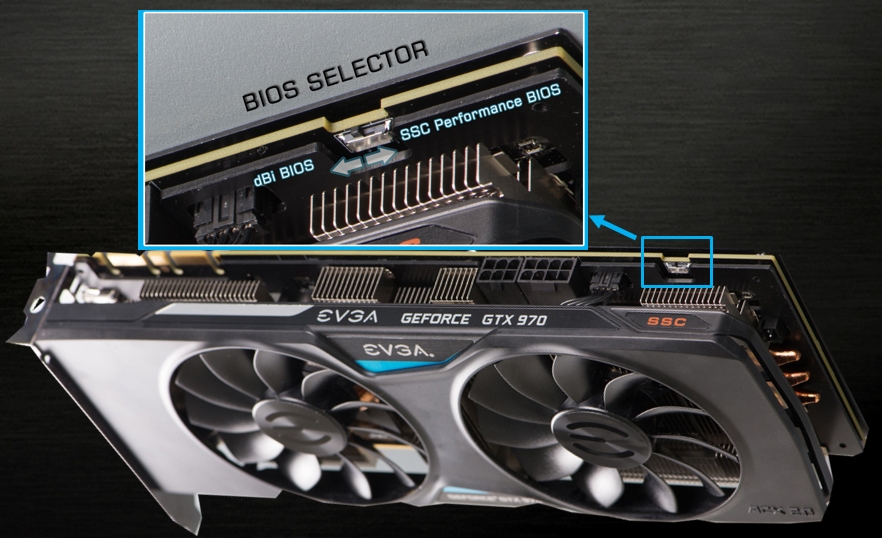
Now the second difference: cooling design. The FTW edition has a very unique heat pipe architecture to the SC/SSC even though they are all under the ACX roof. Take a look:
This is from a FTW graphics card (image source : fudzilla)
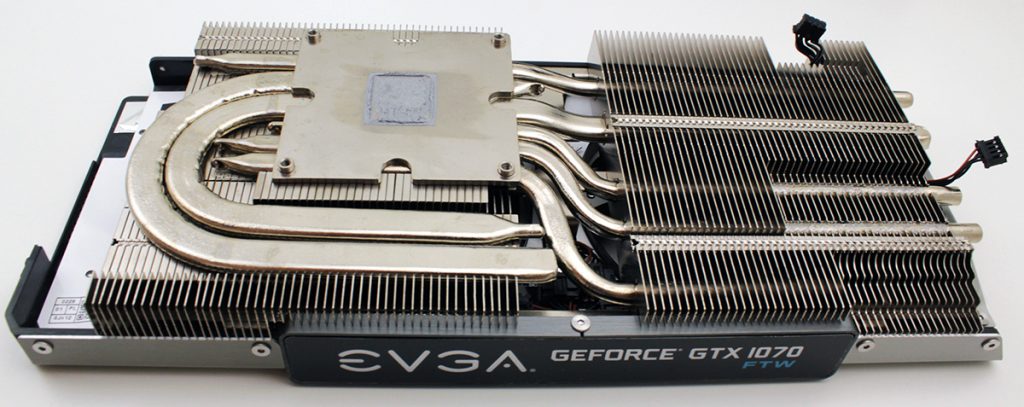
And this is from a SC/SSC graphics card (image source : eteknix)
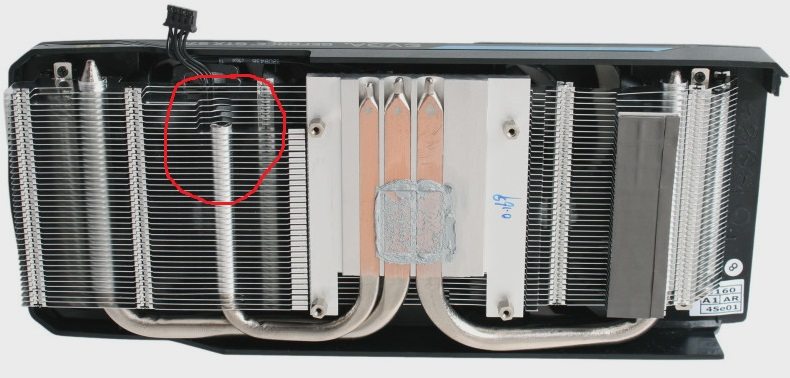
If you were wondering why one of those 3 heat pipes does not have thermal paste on it, you have found a drunken mistake in design of the ACX 1.0 architecture. The heat pipes misaligned and not all of them touch the GPU, thus older GTX 970 SSC/SC edition ran pretty hot. Fortunately, that has been fixed under ACX 2.0, but this type of design remains the same for newer SC and SCC models, even in ACX 3.0 update.
Basically, there are more heat pipes in the FTW model and they are connected to a very large, solid cold plate that touches the GPU; while the SC/SSC has their fewer heat pipes and they are in direct contact to the chip. The FTW model also has taller and thicker copper-fin array heatsink.
Another thing to note is the fan blade design.
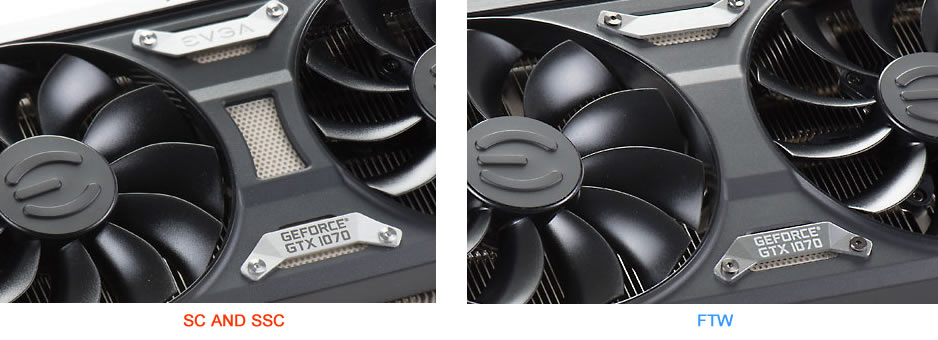 If you pay close attention to the picture of the SC/SSC above, you should notice that each fan blade is raised up a little towards the edges, starting along the side of the fin. This horizontal fin design can greatly affect the direction of air flow. They tend to push some of the hot air outside of the case and some to the front panel direction.
If you pay close attention to the picture of the SC/SSC above, you should notice that each fan blade is raised up a little towards the edges, starting along the side of the fin. This horizontal fin design can greatly affect the direction of air flow. They tend to push some of the hot air outside of the case and some to the front panel direction.
The FTW model on other hand has a vertical-blade fans which act like a scoop.
Large volume of hot air is now picked up from the heat sink and vented to the bottom of the chassis, some may escape and vented out from the circuit board.
Shorter distance of travel means higher air flow could pass by the heatsink, which results in a difference of up to 4°C (~7.2°F) in thermal temperature between FTW and SC/SSC. However, the drawback of this design is it’s bad for SLI setup –not like the GTX 10-series could do SLI anymore anyway, but those who plan on SLI GTX 900-series may find these models releasing a little too much hot air to their neighbor. In that case, best to go with SSC.

Last of all and also the lesser known fact, The SSC/FTW model is usually equipped with a more powerful VRM controller used in the flagship model. For example, the GTX 1070 FTW has the same NCP81174 controller that’s found in GTX 1080 lineup, which is capable of delivering higher voltage (1.215v+) for overclocking purpose. With a power phase of 10+2, you could do some major super charge to the FTW and SSC.
Other models of GTX 1070 such as the REF, Founder’s and SC edition have only 4+1 power phase and a locked voltage, hence requiring just an 8-pin PCIe connector instead of 8+8 pin connectors. The flagship GTX 1080 all have 5+1 power phase, except for GTX 1080 FTW, FTW DT that have 10+2.
Ok now the moment of truth, what’s the difference between the FTW DT and FTW?
You have learned that GPUs are binned into different Tiers. If you don’t, you probably just skipped the beginning of this post. The good news is, that isn’t important anymore here.
All you need to know is that FTW and FTW DT are both in the same top Tier. FTW DT, with DT instead of it stands for derp team like I hoped, EVGA says it actually stands for Standard (go figure), meaning this version does not come factory-overclocked. That’s all.
Out of the box, FTW DT runs at REF Tier’s clock speed and boost speed. Yet FTW DT has the same fancy cooling design as the original FTW with 10+2 power phase, RGB LED, and a powerful VRM controller that powered the GTX 1080. Those are the features that REF/SC/SSC editions don’t have.
So if you want to try your luck on manually overclocking something better than SC/SSC but don’t need the factory-overclocked FTW, hit up the FTW DT. It may have some great potentials to your surprise, albeit the silicon lottery also plays a role in the final outcome.
- Real Base Clock: 1506 MHz / Real Boost Clock: 1683 MHz; Memory Detail: 8192MB GDDR5
- Completely adjustable RGB LED using EVGA Precision XOC
- What you see is what you get! – No additional software required to achieve listed clock...
- Double BIOS. Revolutionary new 360-degree image capture
- Real Base Clock: 1607 MHz / Real Boost Clock: 1797 MHz; Memory Detail: 8192MB GDDR5
- Completely adjustable RGB LED using EVGA Precision XOC
- What you see is what you get! – No additional software required to achieve listed clock...
- Double BIOS. Revolutionary new 360-degree image capture
Early 2017 (it was on Friday), EVGA officially announced the ICX variant for the FTW and SC editions. This new technology is basically an improvement of the older ACX cooling system. Buckle up and this 2-min video will explain everything you need to know about these EVGA ICX GPUs and how it compares to the older sibling ACX’s.
Here are the highlights:
- ICX has a total of 9 thermal sensors, each monitored individually by its own MCU (microcontroller unit). Meaning you have a more detail temperature information all across the PCB, great to know where the fire actually started. You know I’m kidding right…only Samsung phone does that.
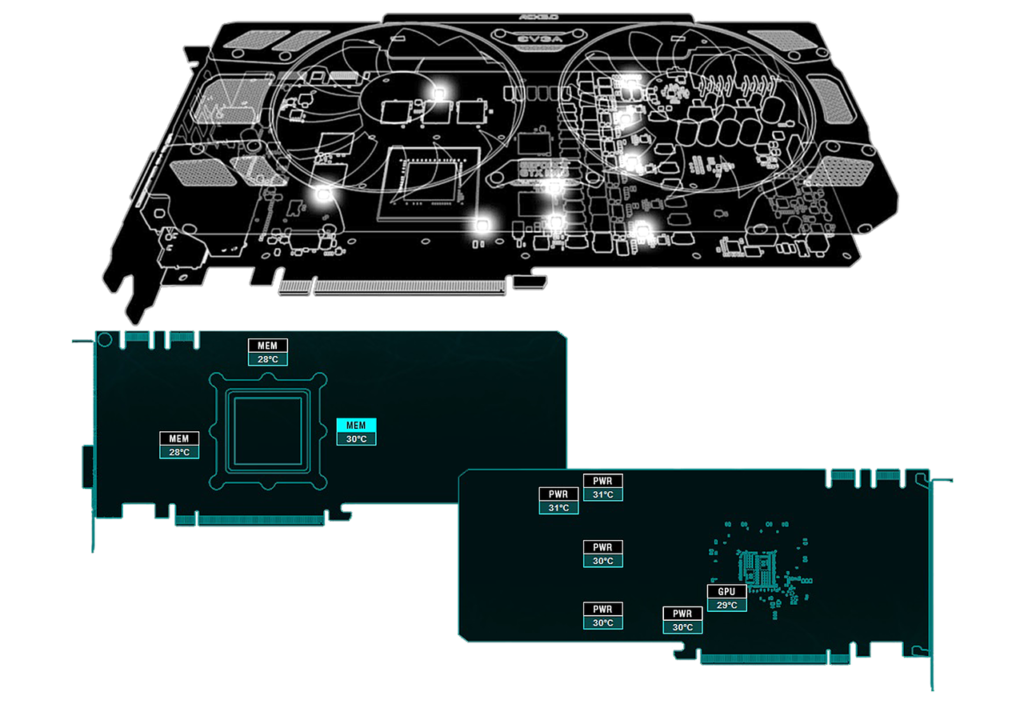
- You can control the two fans simultaneously or asynchronously. Meaning you have the control to let them spin at the same speed everytime or do it seperately. If you opt for the second choice, left fan speed is determined by GPU temp and right fan speed is triggered by PWR and Memory chips temp.
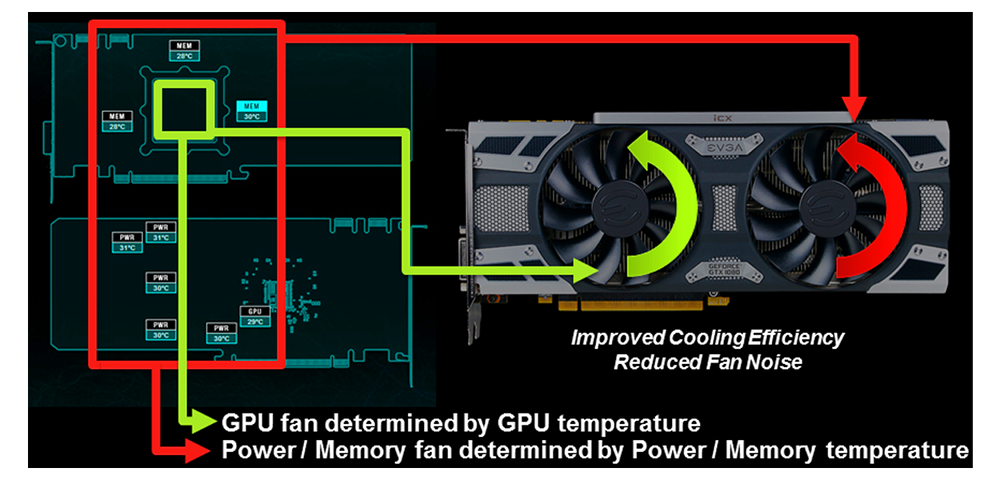
- It has customized thermal LEDs that compel evils and darkness. Still can’t stop Trump from tweeting.
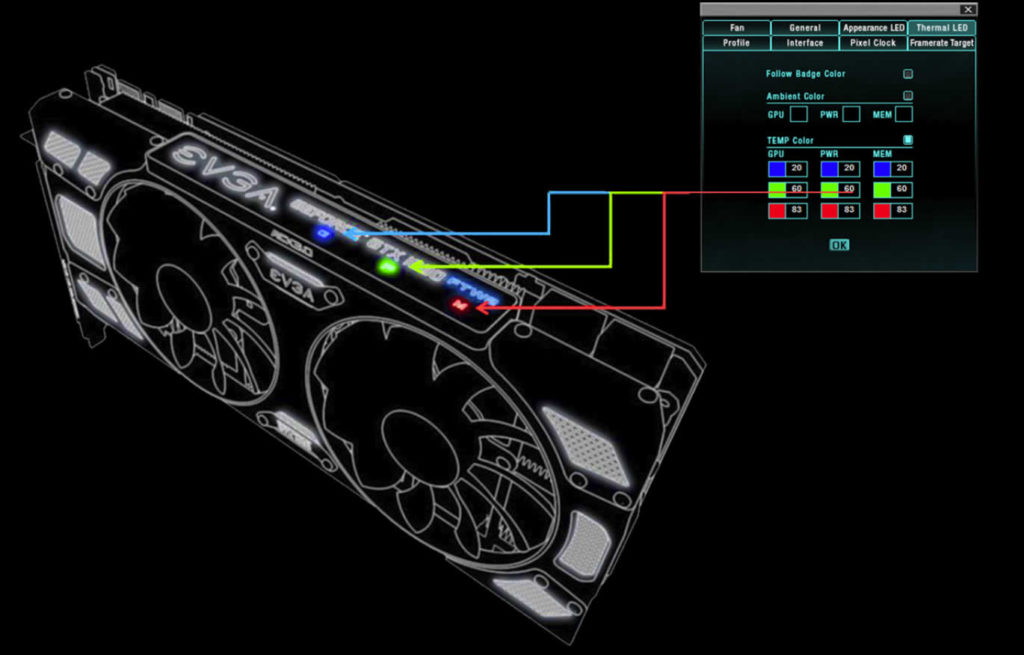
- ICX comes with more advanced copper fin designs.
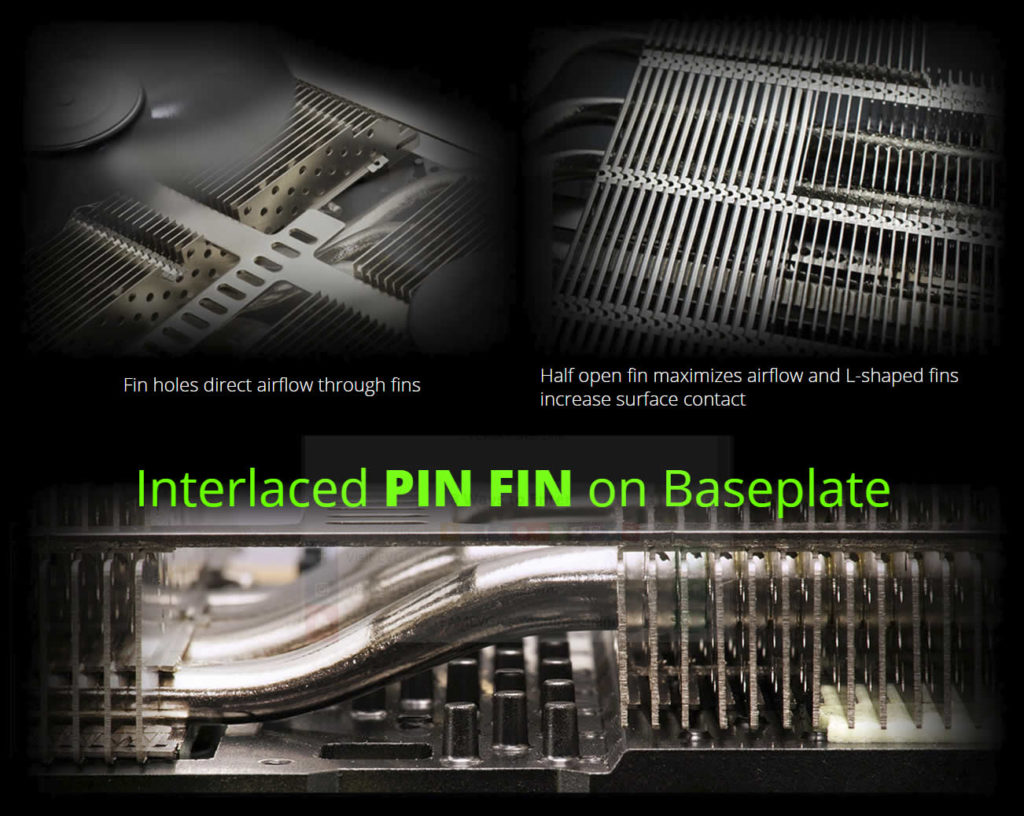
- Real Base Clock: 1607 MHz / Real Boost Clock: 1797 MHz; Memory Detail: 8192MB GDDR5
- EVGA iCX Technology - Asynchronous Fan Control
- 9 additional temp sensors to monitor Memory and VRM
- GPU / Memory / PWM Thermal Status Indicator LEDs. Requirement-Two available 8-pin PCIe...

So it’s half air cooled and half liquid cooled. It’ll be a decent overclocker, but you still have to cross your fingers when picking up one. Silicon lottery, remember?
- Real Base Clock: 1708 MHz / Real Boost Clock: 1847 MHz; Memory Detail: 8192MB GDDR5X
- EVGA Hybrid - "All in One Cooling" w/o the Hassle, Just Plug and Play! Keep GPU 20-30C...
- What you see is what you get! – No additional software required to achieve listed clock...
- DX12 OSD Support with EVGA Precision XOC
*There is also a FTW Hybrid, and as you may have guessed it’s the the regular FTW with the sweet liquid-cooling setup.
The Classified comes with Triple BIOS switch for those hardcore O.C enthusiasts.
Another major difference is that it has 14+3 power phase which delivers up to 245W of power, instead of 10+2 power phase for 215W of the FTW model. And of course it also has to look a little different to the rest of the family. Imagine supper saiyan 2 vs. 3.

- Real Base Clock: 1721 MHz / Real Boost Clock: 1860 MHz; Memory Detail: 8192MB GDDR5X
- Run Longer, Play Longer with EVGA "ACX 3.0" Cooling
- What you see is what you get! – No additional software required to achieve listed clock...
- DX12 OSD Support with EVGA Precision XOC
As you already know, the GTX 1080 FTW edition has RGB LED, 10+2 power phase, 8+8 pin connectors and overclocking capability up to 30% more than SC and REF editions –and the Hydro Copper with a thick waterblock could just bring overclocking potential to an unknown location.
It won’t be an easy walk in the park though, you will first need to have your own custom liquid cooling setup ready before going anywhere with this bae. It’ll be worth it.
- Real Base Clock: 1721 MHz / Real Boost Clock: 1860 MHz; Memory Detail: 8192MB GDDR5X
- Exclusive EVGA Solid Copper Block - Provides best thermal performance available for liquid...
- Completely adjustable RGB LED using EVGA Precision XOC
- What you see is what you get! – No additional software required to achieve listed clock...
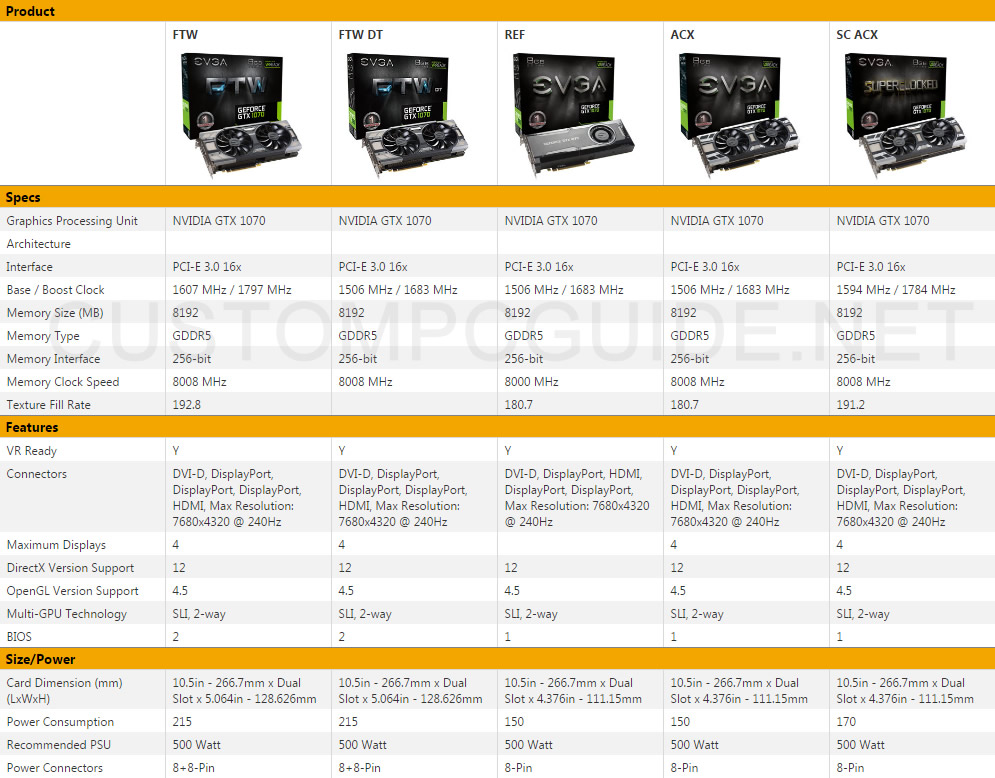
EVGA GTX 1080 GPUs
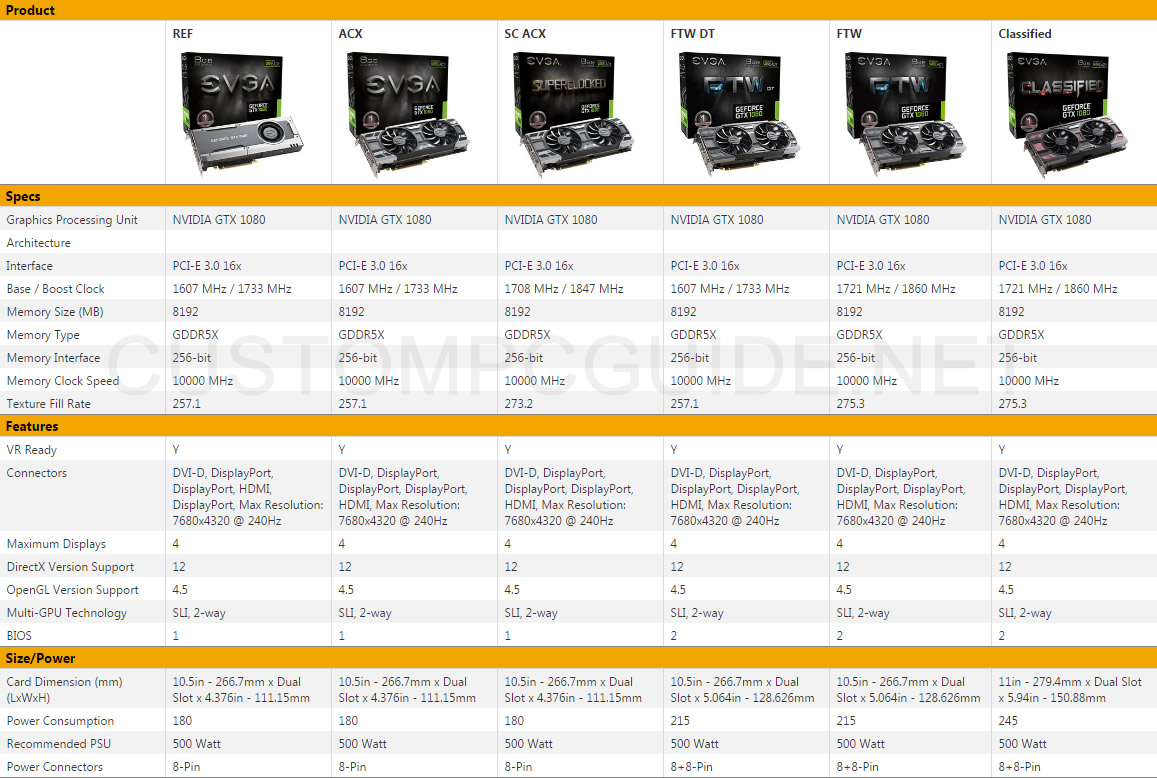
| EVGA GTX 1070’s – Rise of the Tomb Raider 1080p I had some spare time and happened to have a few EVGA GTX 1070s left before the give-away sweepstakes on CPG facebook page, so I got you the smallest benchmark ever posted.  |
|
| EVGA GTX 1070 FTW | |
| EVGA GTX 1070 SC | |
| EVGA GTX 1070 REF | |
Well, that’s it.
Not too terrible right. Wanna read another one? You won’t be disappointed.
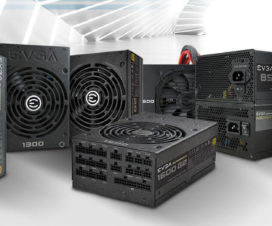 PSU The differences between EVGA W, B, BT, BQ, B3, G, G+, GQ, GS, PQ, P2 and T2 Power Supply
PSU The differences between EVGA W, B, BT, BQ, B3, G, G+, GQ, GS, PQ, P2 and T2 Power Supply
 CPU Differences between Coffee Lake i7-8700K, i5-8600K vs. Kaby Lake and Ryzen 7
CPU Differences between Coffee Lake i7-8700K, i5-8600K vs. Kaby Lake and Ryzen 7
 SSD Samsung 960 Pro / Evo versus 950 Pro and 850 Series
SSD Samsung 960 Pro / Evo versus 950 Pro and 850 Series
Not in the mood for reading? Perhaps you could answer everyone a quick question before their shopping day: Which one of the above models would you choose? It’d certainly help future builders make their decision a bit easier. Thanks and see you again someday!









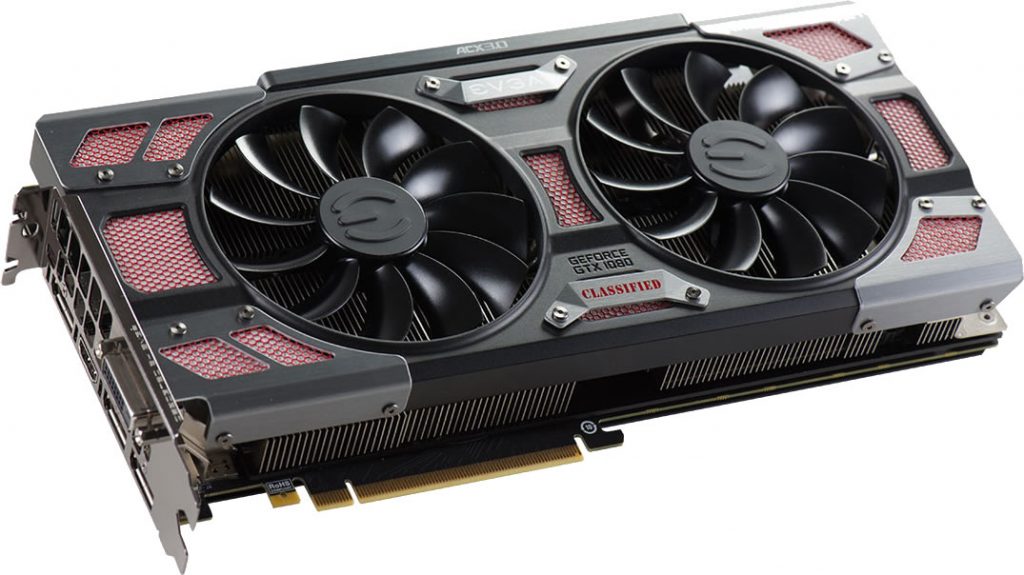

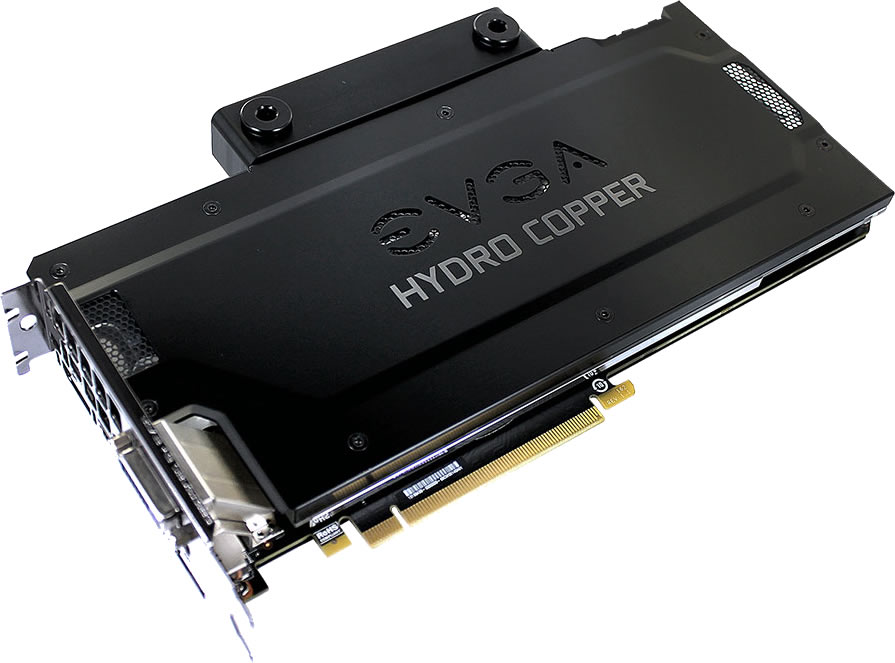

Very interesting and one of the great reviews/ knowledgeable artcle. I was looking specidcally for this one. Great job there. Keep it up
Great review thanks
This is honestly one of the single best articles I’ve ever read. You have outperformed every other computer enthusiast by delivering a very thorough presentation on gaming GPUs that isn’t clouded with industry jargon and bias. Seriously, get job on this article. It’s a masterpiece.
I only came here to see what my ACX meant (I just bought an EVGA 1060 3GB Gaming ACX), but I ended up reading the entire article. I can say with 150% honesty that this has been one of the most worthwhile reads I’ve seen in at least a year.
Edit – 3rd Line — Meant to say “great job” not “get job”
Edit – 4th Line — Disregard the “my”
(I wish I had the ability to edit my comment (ಥ﹏ಥ)
Great now the wraith of 1933 grammar Nazi is forever upon you! But on other note, thanks a lot for the great feedback. I’m very glad you enjoyed the article and thus become an EVGA Jedi yourself. Use this knawledge responsibly and help those who can even afford a 1060 :)
Hey guys, great article! Somehow I missed the “Ti” dditions on this pages or am I blind?
It’s not you, it’s me.